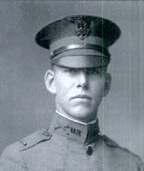Pat Finnegan (1917-1918)
Variously referred to as Alexander P. Finnegan or Patrick A. Finnegan, "Pat" played one season in the war-shortened 1917-1918 basketball schedule, seeing action in 13 of 14 games.
Following the season, Finnegan left Georgetown for Plattsburgh NY to join the U.S. Army. Soon after his commission as a second lieutenant, he died in Philadelphia during the influenza pandemic of 1918.
A 1999 book titled "The Irish Of Haverhill" wrote the following: "His parents were born in Ireland and both immigrated in the 1880's. His father, John, was an engineer at the Haverhill Boxboards...Patrick, who enlisted in 1918, was commissioned a second lieutenant, assigned as an instructor to Temple University in Philadelphia. He died in that city in October of 1918." Although he was not killed in combat, Finnegan is one of three Georgetown basketball players who have died in military service and is recognized by Georgetown among its war dead.
"Here it is necessary to pause sadly and record the untimely death of Pat Finnegan, a victim of influenza after just gaining his commission at Plattsburg," wrote the Ye Domesday Booke yearbook. "In his death [the class of 1921] suffered a genuine loss, for he was one of our ablest and best-liked."
At the conclusion of the 1918-19 academic year, a memorial was held at Georgetown for its war dead.
"On Sunday morning at 10:30 o'clock the "sons of Georgetown" gathered at the College and bowed their heads in prayerful tribute to the 54 graduates of the university who died in the World War fighting for democracy," wrote the yearbook. "Headed by Chief Justice White, of the United States Supreme Court, and Dean George E. Hamilton, of the law school, the alumni marched in a procession to Dahlgren Chapel in the College quadrangle, where an impressive military Mass was held in honor of the dead heroes. Three volleys were fired in slow salute by the two cadet companies of the reserve officers' training corps, commanded by Maj. William H. Hobson, during the playing of the inspiring "Deo in Excelsis." Then the strains of the soldier's "taps," sounded by a bugler from Fort Myer, gave the signal for the close of the religious ceremonies. As the choir of Trinity Church sang "My Country 'Tis of Thee" the assembly marched out of the chapel to the college halls. They passed between the rows of cadets, who stood at military salute."
Fifty four poplar trees, one for each man, were planted at the site that day. None survived. A decade later, with its memory since forgotten, the trees were bulldozed in the construction of Copley Hall.
| Season | GP | GS | Min | FG | FGA | % | 3FG | 3GA | % | FT | FTA | % | Off | Reb | Avg | PF | Ast | Blk | Stl | Pts | Avg |
|---|---|---|---|---|---|---|---|---|---|---|---|---|---|---|---|---|---|---|---|---|---|
| 1917-18 | 13 | 22 | 1.8 | ||||||||||||||||||
| Totals | 13 | 22 | 1.8 |
